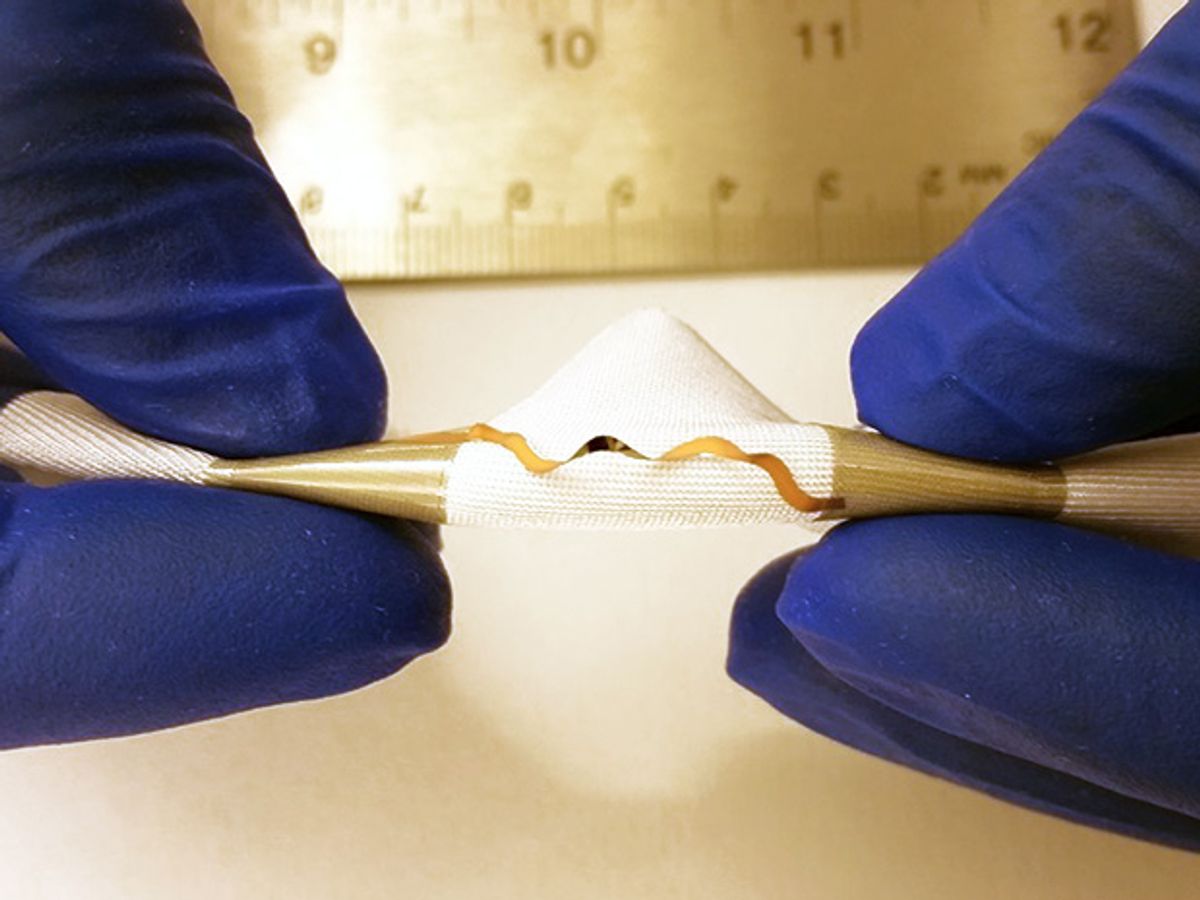Imagine a flexible antenna attached to a sports shirt wirelessly sending health and fitness data from sensors on the body to a smartphone hundreds of meters away. Such a vision for wearable devices has proven impractical—that is, until now. But a new antenna design has proven its ability to withstand the bending and stretching that garments endure, while steadily communicating via Wi-Fi.
The device, developed at King Abdullah University of Science and Technology (KAUST) in Saudi Arabia, is the first antenna capable of maintaining a steady communication frequency despite being twisted and stretched. A paper describing the antenna was published in the 6 Oct 2015 online issue of the journal Advanced Functional Materials. Researchers used a helical spring design—similar to Slinky Dog from the movie Toy Story—so that the antenna can always spring back to its original form. For added restorative force, meant to ensure it was not permanently bent out of shape, the researchers built the copper antenna on top of a polymer layer.
“The design helps us go for something where size can be compacted but can also conform with our body contours which are irregular, asymmetrical body surfaces,” said Muhammad Mustafa Hussain, an associate professor of electrical engineering at KAUST. “It can go with the flow.”
Such a stretchy antenna could enable future wearable devices to measure athletes’ body temperature, oxygen saturation, and blood pressure during workouts. Physicians and nurses could also better keep tabs on their patients’ vital signs with wireless health sensors.
Standalone testing showed the antenna could communicate in the standard Wi-Fi frequency range across distances of up to 140 meters—about one and a half soccer fields. A boost in the transmission power from 1.25 milliwatts to 10 milliwatts increased the maximum range to 394 meters.
But the key test was measuring the antenna’s performance as part of a garment worn by a human. Hussain’s lab tested the antenna on a piece of stretchable fabric worn on a person’s forearm and biceps with the outside help of John Rogers, a materials science professor at the University of Illinois who has done much pioneering work in flexible electronics.

This human body testing showed that the antenna could broadcast signals as far as 225 meters, depending on the transmission power levels. That represents a potentially huge performance boost over today’s wearable and mobile devices; they mostly use Bluetooth, and are therefore limited to about 10 meters. Hussain’s group plans to replace the Bluetooth transmitter in a smart watch with the new, flexible antenna to measure the potential boost in transmission range.
In the future, such extended range could enable people to leave their phones inside their apartments while still monitoring their workouts in the gym on the rooftop of the building. Office workers wearing smart watches or other wearable communication devices could also leave their phones behind and still take calls while walking outside during lunch hour.
The flexible antenna’s ability to transmit a steady, constant frequency in the Wi-Fi range—despite being stretched and bent—represents a huge leap compared with previous flexible antennas. Past flexible antenna prototypes changed transmission frequencies when they were bent out of shape. That may be suitable for tunable frequency devices, but most wearable or implantable devices rely on constant frequency.
Such flexible antennas could prove a crucial stepping stone toward having more flexible, stretchable versions of today’s mostly rigid smartphones and tablets. They could also go a long way toward enabling the future vision of the “Internet of Everything” or “Internet of Things,” with any and all devices or living beings connected wirelessly by tiny sensors, Hussain said.
That future could happen sooner rather than later because the new antenna uses copper, an abundant, low cost material already used in many modern technologies. To help with faster adoption, Hussain has always made a point of using materials and technologies compatible with today’s semiconductor manufacturing techniques. He envisions the new antenna potentially reaching the manufacturing stage in three years.
“Why wait 50 more years until nanomaterials qualify?” Hussain said. “We can start with existing materials and technologies to make rigid devices into stretchble and reconfigurable ones.”
Jeremy Hsu has been working as a science and technology journalist in New York City since 2008. He has written on subjects as diverse as supercomputing and wearable electronics for IEEE Spectrum. When he’s not trying to wrap his head around the latest quantum computing news for Spectrum, he also contributes to a variety of publications such as Scientific American, Discover, Popular Science, and others. He is a graduate of New York University’s Science, Health & Environmental Reporting Program.



